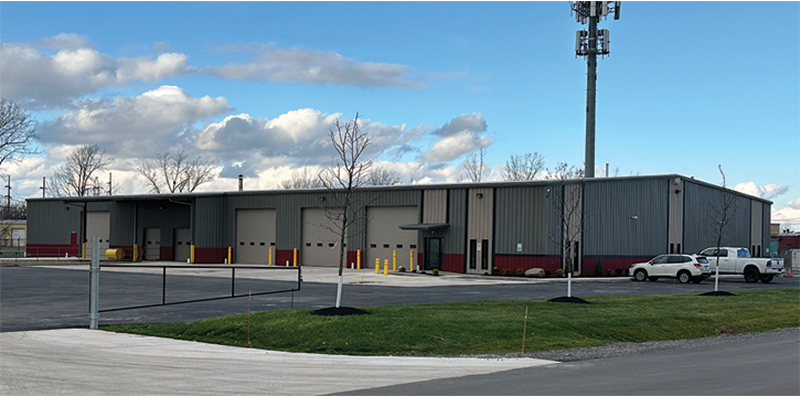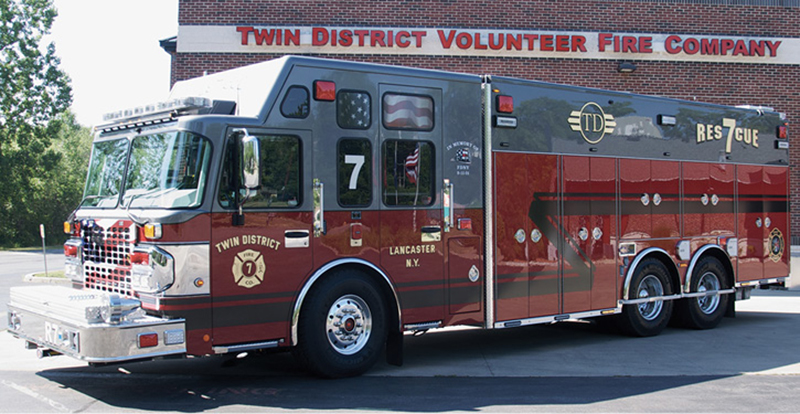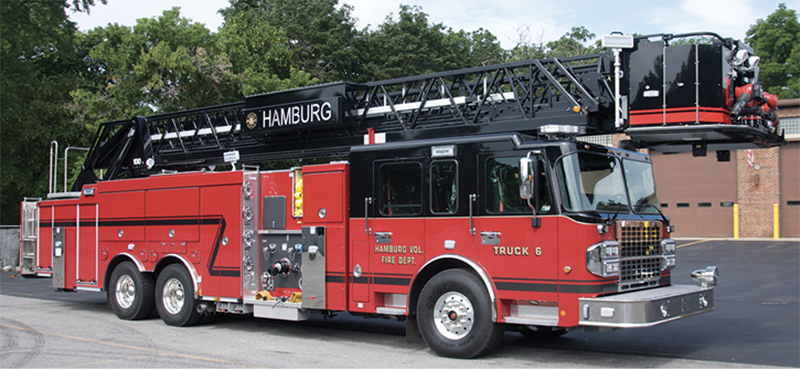By Bill Adams
Many fire apparatus dealerships were established when a firefighter started a business after becoming enamored with fire trucks—most likely when the local fire department took delivery of a new rig.
Selling apparatus part-time usually led to adding ancillary (loose) equipment and, as time progressed, it became a full-time occupation. A brick-and-mortar facility usually followed that evolved into providing service, repair, and maintenance work of varying degrees. Colden Enterprises, Inc. was a well-established collision and heavy truck repair facility prior to beginning fire apparatus sales.
It started when two construction workers in Western New York, Charles Galante and Michael Grisanti, were repairing their own heavy trucks as well as trucks for other contractors in their industry. They went into the heavy truck repair business full time. Planning on relocating to Colden, New York, in 1977, they incorporated their business as Colden Enterprises, Inc. They ended up on Ontario Street in Kenmore, a Buffalo, New York, suburb. Almost 50 years later after making three additions and recently purchasing another building, they’re still on Ontario Street.
Kevin Brooks Sr. is Colden’s principal owner. He started with the company in 1983 as a painter. Five years later, he was a shop foreman and soon became an equity partner. In 2013, he became sole owner. His son, Kevin Brooks Jr., started in the business after college in 2003.
In the 1990s, Colden became a fire apparatus dealer when Kevin Brooks said, “We recognized the potential for branching off into this field for additional growth.” Shortly thereafter, the fire apparatus industry immersed itself in buy-outs, closures, mergers, and rebranding.
Today, Colden has two separate divisions. Its Fleet Services Division, specializing in the heavy truck collision work and repairs, is managed by the senior Brooks. Brooks Jr. manages the Fire & Rescue Division. Neither were involved in the fire service.


1 2 Colden’s Fire & Rescue Division recently moved into a 25,000-square-foot building in Kenmore, New York. Colden repairs, services, and performs maintenance on other than Spartan apparatus. (Photos courtesy of Colden Enterprises, Inc.)
Since 1995, Allan Smith sold part time for an apparatus manufacturer that later became absorbed through the mergers. In 2004, Colden hired him as a full-time apparatus salesman after he retired with 26 years of service with Eastman Kodak’s privately owned Kodak Park Fire Department, a three-station career entity in Rochester, New York. He is an active member and past chief of the Hamlin (NY) Fire Department. In 2010, Smith became Colden’s fire apparatus sales manager.
When Smith hired on, Colden was representing Crimson Fire, which was renamed Spartan ERV (Emergency Response Vehicles) and then Spartan ER (Emergency Response). Colden still represents Spartan ER. In 2017, when Spartan ER purchased Smeal, which had previously acquired LTI (now Ladder Tower), Colden picked up both those lines. In addition, it represents Rescue1, PL Custom, and Summit Fire Apparatus. Both Smith and Brooks Jr. contributed to this article.
FACILITIES AND SERVICE
The Fleet Services Division occupies 43,000 square feet. A recently purchased 25,000-square-foot building, also on Ontario Street, is home to the Fire & Rescue Division. Colden employs about five dozen people with more than one third on the fire side. In 2021, a 2,000-square-foot facility for the Fire & Rescue Division’s sales and apparatus road service opened in Syracuse, New York.
Colden has been doing antique fire apparatus restorations since 1977. In the early 1990s, it became more involved with fire apparatus repair and maintenance after becoming an apparatus dealer. Besides body work, collision repairs, and repainting, it performs general fire apparatus repair and maintenance as well as pump work. Annual maintenance inspections and aerial and pump testing are offered. The Fire & Rescue division’s service manager is Jeff Davis. Mechanics are EVT-certified.
In addition to in-house work, there are three on-the-road service trucks—two out of the Kenmore office and one out of the Syracuse office. 24/7 emergency service is provided. Smith says, “When Colden services and repairs a fire truck, we are experienced and capable of doing everything from repairing a 1-inch gate valve to straightening a frame rail to repainting the entire apparatus. We have frame-straightening machines, an all wheel laser alignment machine, and four paint booths and can rechassis and rebody apparatus with our own employees. We have some service people who work strictly on fire apparatus.”

3 This Chittenango, New York, 1,500/1,000 rescue-pumper has a Star Series stainless steel body on a Spartan Gladiator cab and chassis featuring upper coffin style storage compartments and an overhead ladder rack on the right side.

4 Tanker 29 is built on a Spartan Metro Star chassis with Star Series stainless steel body and pump module and was delivered to Bergen, New York. It has a 1,500-gpm pump, 2,000-gallon tank, hydraulic generator, rear swiveling dump valve, and dual crosslays recessed in the extended front bumper. A 2,500-gallon portable tank is carried on the left side.

5 The Lancaster, New York, Twin District has a Rescue1 aluminum walk-through rescue body mounted on a Spartan Gladiator chassis with a 24-inch raised roof. It features a PTO-operated 15-kW generator, a light tower, and painted hinged doors.

6 Hamburg, New York, runs a Spartan ER 100-foot rear-mount aerial ladder platform mounted on a Gladiator chassis, with a 2,000-gpm pump, 300-gallon tank, Star Series aluminum body and pump module, and hydraulic generator.
SALES
Colden says 15% of its apparatus sales are aerial devices, 10% rescues, 5% tankers, and 70% custom pumpers. Most fire departments in its marketing area are volunteer. The apparatus sales staff is predominantly full-time. The original apparatus sales territory was Western New York. After Spartan became part of the REV Group, Colden’s territory extended to cover Central New York; shortly thereafter, the Syracuse facility was opened. The Syracuse location also handles Holmatro rescue tool sales and service in Central New York. Colden does sell ancillary equipment not supplied on new apparatus but presently does not have a formal equipment division for it.
Regarding apparatus sales in general in Colden’s territory, Smith says, “Almost all custom cabs have six seats with a 10-inch raised roof. Two-door tankers are common. Preferred body materials are 75% aluminum and 25% stainless steel. Nonmetal bodies are not popular. Red is the predominant paint color. There is a trend in two-tone paint schemes breaking from white over red to darker upper colors like gray and black, with black over red most common.
About 95% of pumper sales have custom chassis with 1,500-gpm pumps and 1,000-gallon booster tanks. All are equipped for large-diameter hose, and half feature onboard foam systems. Only about a quarter of pumper sales are pumper-rescues.
Most of the aerial sales are six-seat rear-mount quints—about 80% aerials and 20% towers. The most popular aerial device length is 105 feet. Tractor-drawn aerials are not popular in the marketing area.
Six-seat custom chassis with large walk-around rescues account for about 75% of [rescue] sales. About 5% are wet rescues with a small pump and booster tank.
Tanker chassis are split 50/50 between custom and commercial. Most popular tankers have 2,500-gallon rectangular tanks with 1,500-gpm pumps.”
Brooks Jr. and Smith answered the following questions.
In your marketing area, have most purchasers predetermined the manufacturer they want to purchase from, or do they actively compare OEMs?
A mix of both. The trend seems to lean toward predetermined manufacturers.
Do purchasers follow National Fire Protection Association (NFPA) standards 100%?
Typically, yes.
Do career departments purchase via competitive bidding or through co-ops?
We have seen both, with the trend leaning toward co-ops.
How do volunteer departments commonly purchase?
If they are incorporated and not part of a municipality, they tend to purchase what they want. It has become more common as of late for volunteer departments to negotiate sales without public bidding. Some fire districts and villages still insist on the bidding process due to past practice.
Are fire departments’ purchasing specifications usually proprietary, generic, or performance-based?
A majority of specifications we see are proprietary.
Do departments write their own specifications or solicit outside help from vendors and consultants?
Most purchasers utilize outside help. When they write their own, many times they try to choose the best features of several manufacturers, resulting in a specification for an apparatus that can’t be built!
During the public bidding process, does the authority having jurisdiction require bidders to “meet the specs” or are they just interested in “low bid” regardless of compliance?
Good question. We have seen many cases where the boilerplate will be very specific about compliance to the specification only to see those requirements ignored during the bid review process.
Is there a trend toward multifunction apparatus such as pumper-tankers and pumper-rescues?
Yes. Many agencies are combining apparatus functions and downsizing their fleets due primarily to fewer personnel being available to move multiple pieces of apparatus to an incident.
Do purchasers tend to stay with “standardized” apparatus or do they “reinvent the wheel” when they spec rigs?
Both. But the trend appears to be toward more standardized apparatus due to the cost associated with fully customized units.
Do you sell many stock or demo rigs?
This is another trend that we see happening—that of agencies grabbing a stock or demo unit in lieu of waiting for the build process to play out.
Are NFPA 1906, Standard for Wildland Fire Apparatus, wildland-type apparatus very popular in your territory?
Not really. Some agencies utilize pickups with skid units for off-road brush fire type incidents.
Has there been much interest in the “clean cab concept”?
We haven’t seen the removal of the SCBA portion of the concept from the cab yet but are seeing an increase in cabin air filtration, washable cab interior surfaces, and washable seat coverings being requested.
Did COVID-19 have much of an impact on your apparatus business?
Yes. The regular meetings with apparatus purchasing committees fell off dramatically. It caused an increase in virtual meetings or a lot of back-and-forth interaction electronically in order to keep projects on track. However, agencies were still making purchases even though the process was much more complicated.
How is the current economy impacting your apparatus business?
We haven’t seen a change in the business despite record lead times and costs. Fire departments still need to update their fleets, so they are still making purchases.
Is there a concern in your territory about the “brightness” of LED warning lights?
Somewhat. Customers are now asking about dimming features on the lighting packages.
Are many apparatus equipped with light towers?
Usually on rescues or rescue-pumpers.
With the acceptance of LED scene lighting and battery-powered hydraulic rescue tools and smoke ejectors, are onboard generators still popular?
There are definitely fewer onboard 115-volt generators.
Does Colden do much tool mounting prior to an apparatus delivery?
Yes, we have a dedicated fab area with a 10-foot brake and 10-foot shear.
Any comments about apparatus manufacturers merging?
It would appear that the buying power of components would be strengthened, resulting in better cost control.
Do you have any words of wisdom for new fire apparatus purchasers?
Have a plan on what the apparatus needs to consist of before you engage vendors. Don’t be afraid to look at multiple brands initially before narrowing down your choices and don’t forget that service should play heavily into your decision making. Buying apparatus from a dealership that doesn’t have a viable service facility within a reasonable distance will be cause for great frustration down the road. The same applies to reliable in-station road service.
Do you find it difficult to sell fire apparatus in such close proximity (24 miles) to a competitive apparatus manufacturer’s factory?
Not really, it’s all about establishing and maintaining a good working relationship with the customer.
BILL ADAMS is a member of the Fire Apparatus & Emergency Equipment Editorial Advisory Board, a former fire apparatus salesman, and a past chief of the East Rochester (NY) Fire Department. He has 50 years of experience in the volunteer fire service.

